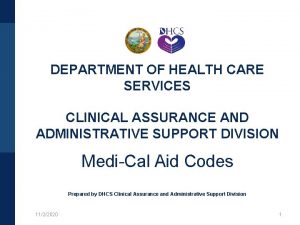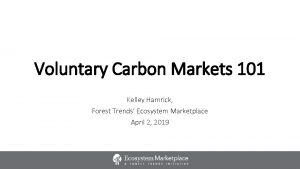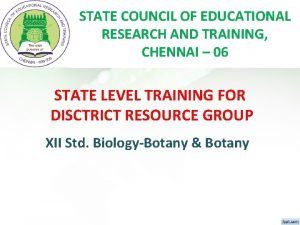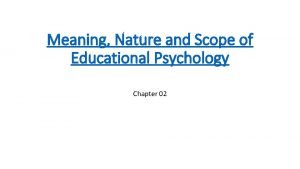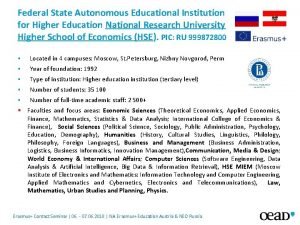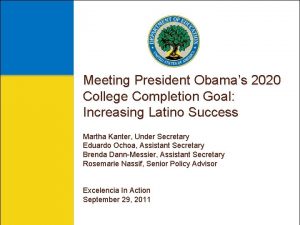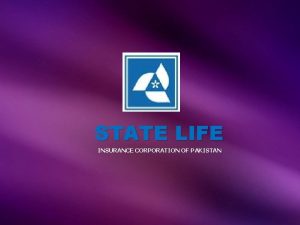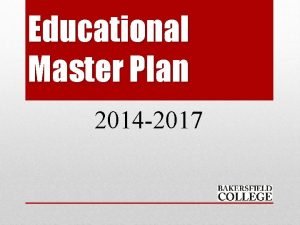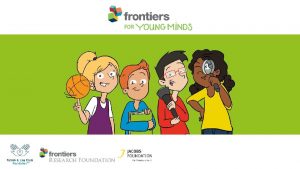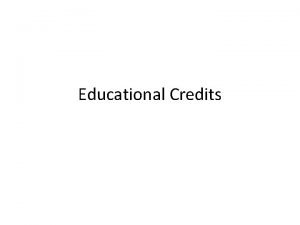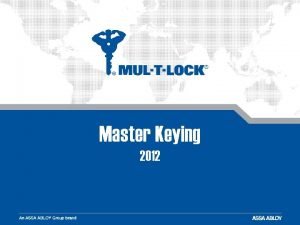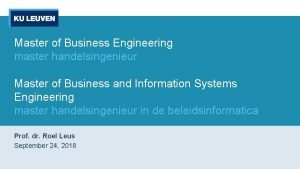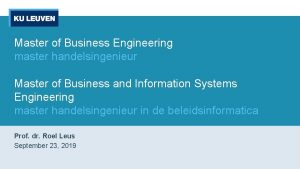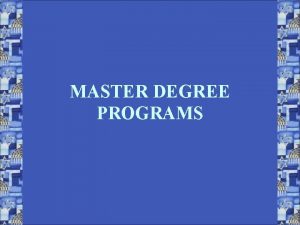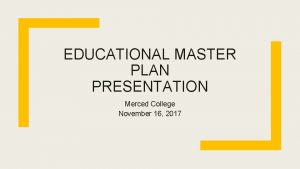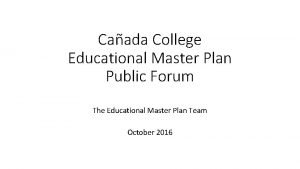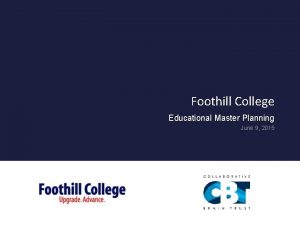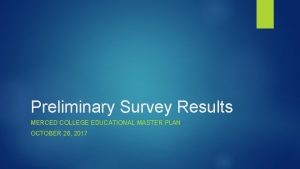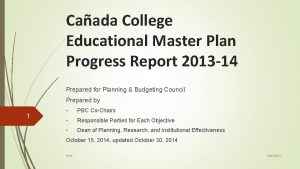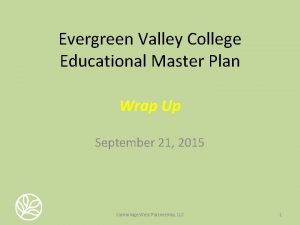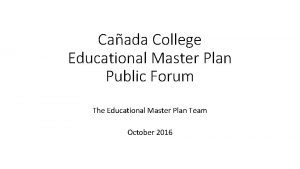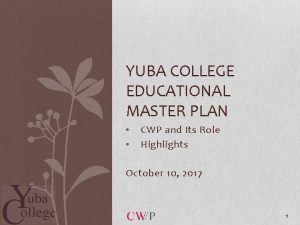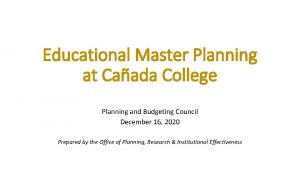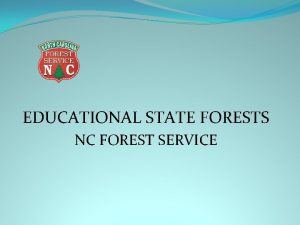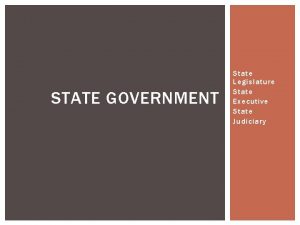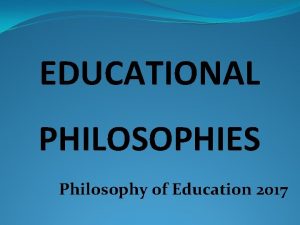State of the College 2017 2020 EDUCATIONAL MASTER









































- Slides: 41

State of the College 2017 -2020 EDUCATIONAL MASTER PLAN AND THE INTEGRATED PLAN

Importance of Educational Master Plan Required ◦ Title 5, Section 51008 - Academic Master Plan Expected ◦ ACCJC accreditation activities now “look for” an EMP as part of integrated planning Data and Analysis ◦ Support for the College objectives and action steps ◦ Framing discussions to guide the future of the educational programs and student services ◦ Supporting planning for future capital construction and the Facilities Master Plan

Purpose of the Educational Master Plan 1. The Yuba College Educational Master Plan (EMP) provides a comprehensive overview of the College and the community it serves and includes trend analysis and data projections intended to guide strategic and tactical planning 2. It links the mission to the planning process 3. It is part of the integrated planning process and dynamic in nature and updated annually



Process Overview 1. The Yuba College EMP was written over a 15 -month period 2. College Council managed the development process 3. Feedback and input was solicited from the College community via Compression Planning sessions, surveys, interviews, and governance dialogue 4. EMP web page created early in the process to share information

Yuba College EMP Process Fall 2016 and Spring 2017 ◦ ◦ New College mission statement and Yuba College Guiding Principles created Extensive data collection and analysis (YC Fact Book created) Review of external data, studies and research (see Appendix document) Three compression planning sessions held Summer 2017 ◦ Program questionnaires and group interviews (Student Services and Centers) ◦ Drafting of chapters Fall 2017 ◦ ◦ Program questionnaires and group interviews (Instruction) Drafting of chapters continued Flex Day presentation Governance review and approval

New Yuba College Mission Statement (Adopted 2017) Yuba College prepares a diverse student population to excel in a rapidly changing, interdependent world. Our quality programs and student services empower students to achieve their educational and life goals by providing counseling, transfer preparation, associate and transfer degrees, certificates, career and workforce training, basic skills instruction, and opportunities for lifelong learning. We respond to the diverse educational, cultural, and economic needs of our community by promoting individual potential through effective teaching and learning in an inclusive environment.

EMP Chapters 1. Introduction 2. Environmental Scan and SWOT Analysis 3. Institutional Effectiveness 4. Opportunities for the Future 5. Translating Strategy Into Action 6. Projections for Future Growth

Selected Key Planning Assumptions (Page 21) Politics and Accountability: Federal and state governments will continue to turn to community colleges to address economic and social issues, but there will be increasing calls for accountability Economic Environment: The economic environment will remain stable as will funding Workforce: There will be increasing demand from employers for higher skilled employees Equity: Reducing achievement gaps will remain an important focus of California Community Colleges Demographic and Population Trends: All trends are assumed to remain stable

EMP Core Questions 1. How can the College improve student success, enhance the learning experience and increase completion? 2. What are the emerging labor market needs, transfer opportunities and community educational needs/interests that could impact curriculum and program planning? 3. How much additional or modified instructional space might the College need in the future?

Pathways Framework 1. Benefit of a Pathways model is it allows for the systematic analysis of students’ experiences at all stages of the educational process 2. Provides a framework for strengthening student outcomes at critical connection and progression points 3. Yuba College has developed measurable objectives and actions for each of the stages


Outcomes of the Planning Process 1. The EMP identifies measurable objectives, actions and performance outcomes for four of the five District Goals (See pages 172 to 174) 2. The objectives and actions will be assessed and evaluated regularly by College Council and CEAC to monitor progress

District Goal 1: Increase student success and maximize student experience through learner centered programs and services designed to enhance student learning and completion COLLEGE OBJECTIVE 1. 1 – Connection By June 30, 2020, increase the number of new student enrollments by 6% COLLEGE OBJECTIVE 1. 2 – Entry By June 30, 2020, increase the rate of students completing transfer-level math and English coursework in two years by 8% (IEPI Goal) COLLEGE OBJECTIVE 1. 3 – Progress By June 30, 2020, increase the rate of students persisting from term to term by 9% (Scorecard) COLLEGE OBJECTIVE 1. 4 – Completion By June 30, 2020, increase the rate of students completing certificates, degrees and are transfer ready by 15% (IEPI Goal-Overall #12)

COLLEGE OBJECTIVE 1. 1– Connection By June 30, 2020, increase the number of new student enrollments by 6%. ACTIONS 1. Design, implement and assess a plan to increase FAFSA and Dream Act applications 2. Design, implement and assess a program to increase the number of first-time students receiving an Abbreviated Education Plan (AEP) prior to registration 3. Design, implement and assess an integrated outreach and marketing plan aligning high school outreach activities, parent targeted outreach activities, CTE activities, peer ambassador in reach and outreach, etc 4. Develop promotional materials and a marketing program to increase the awareness of the benefits of the Associate Degrees for Transfer 5. Evaluate the Peer Center/Welcome Center services and scale as appropriate

COLLEGE OBJECTIVE 1. 2– Entry By June 30, 2020, increase the rate of students completing transfer-level math and English coursework in two years by 8% (IEPI Goal) ACTIONS 1. Design, implement, and assess multiple measures 2. Design, implement, and assess a dual enrollment program with all local high school districts 3. Scale and assess the embedded tutoring and embedded peer mentors program 4. Design, implement, and assess a First Year Experience program 5. Design, implement, and assess a Summer Bridge program 6. Attend team to CA Guided Pathways Institutes. Pilot implementation of degree and certificate pathways, meta majors, & process redesign

COLLEGE OBJECTIVE 1. 3– Progress By June 30, 2020, increase the rate of students persisting from term to term by 9% (Scorecard) ACTIONS 1. Transition Early Alert to Student Services and scale and assess the program 2. Implement a curriculum and degree rotational update system 3. Update all out of date degrees and certificates 4. Implement a new catalog development process and interactive, searchable online catalog 5. Expand evaluate the Student Ambassador Club to support peer engagement 6. Implement Degree Audit 7. Develop 5 additional AS-T/AA-T degrees 8. Increase student participation in the Puente, Umoja, and MESA programs by 25% 9. Increase participation in the Student Success Symposiums by 25%

COLLEGE OBJECTIVE 1. 4– Completion By June 30, 2020, increase the rate of students completing certificates, degrees and are transfer ready by 15% (IEPI Goal-Overall #12) ACTIONS 1. Design, execute and assess a process to automatically awarded degrees and certificates 2. Analyze Transfer Center operations, programs and activities. Research statewide best practices and create, implement and assess a Transfer Center Program Plan 3. Initiate faculty to faculty and executive level conversations with key transfer institutions to identify ways to improve transfer outcomes 4. Design, execute and assess a new process to perform degree audits. 5. Design, execute and assess a comprehensive internship and job placement process

Environmental Scan Highlights POPULATION GROWTH: The regional population of both Sutter and Yuba Counties will continue to grow, but at a very slow rate (less than 1% compounded annual growth rate) K-12 ENROLLMENT PROJECTIONS: Enrollment in the K-12 system is projected to be flat for the next eight years. The proportion that is in the traditional college-going age range (18 -24) is expected to decline by 1% during the period 2016 to 2021 INCOME and POVERTY: Except for three areas (Yuba City, Linda, and Olivehurst), the median household income in seven of the ten urban areas in Yuba and Sutter Counties declined between 2010 and 2016 (See page 46 for information on the Opportunity Index)

Environmental Scan Highlights FOCUS ON TRANSFER: Increasingly, Yuba College students are citing transfer as an educational goal. In 2015 -2016 59. 6% of Yuba College students selected transfer as an educational goal, up from 51. 7% in 2011 -2012. STUDENT SUCCESS: Yuba College generally is below state averages on a variety of student success measures. ACADEMIC STAFFING: Twenty-eight percent decline in the number of Yuba College fulltime faculty from 2008 -2009 to 2015 -2016. With this decline there has been an increasing reliance on part-time faculty to maintain and staff programs.

Unduplicated Headcount Trend Source: CW/P (All Yuba College Locations)

Share of Students Where do our students reside? What attracts the out-of-district students? Source: CW/P

Out of District Students What are they taking? Source: CW/P

High School Yields… Source: CW/P

Program of Instruction Key Measures Fall 2016 Source: CW/P

Program of Instruction Key Measures Fall 2016 Source: CW/P

Opportunities for the Future 1. Guided Pathways Redesign o Expansion of Dual Enrollment o Expansion of Noncredit o Seamless Connection to Employment and Transfer o Integrated Student Service and Instructional Support Systems o Degree and Certificate Maps o Meta majors and website redesign 2. Faculty and Staff Visions for the Future 3. Transfer Pathways: Increase AD-T Offerings 4. Labor Market Analysis (See pages 125 -141)

Established Associate Degrees for Transfer

Occupational Gaps, with Yuba College Programs Greater Sacramento and Yuba Metropolitan Statistical Areas 2014 -2024, 10 Largest Occupational Gaps

Occupational Gaps, without Yuba College Programs Greater Sacramento and Yuba Metropolitan Statistical Areas 2014 -2024, 10 Largest Occupational Gaps

Translating Strategy Into Action 1. Movement from a current organizational state to a new preferred one occurs through execution of actions (Porter, 2002) See page 152

Integrated Plan 2017 -2019 SSSP, SE, BSI

Importance of the Integrated Plan • Student Success and Support Programs, Student Equity, and Basic Skills Initiative • Separate funding requirements • Title 5 goal is to promote integration


Areas of Progress Demographic 2013 -2014 2016 -2017 Absolute Difference Student Success Rates in BSI courses 51. 5% 59. 1% 7. 6 Hispanic BSI retention rates -0. 38 3. 26 3. 64 African American BSI retention rates -12. 2% -8. 72% 3. 38 African American BSI success rates -23. 05% -16. 26% 6. 79 Students with a documented disability access rates -9. 34% 3. 76% 13. 1 American Indian/Alaskan Native retention rates in vocational classes -0. 75% 1. 48% 2. 5 Hispanic retention rates in vocational classes -0. 64% 1. 56% 2. 2 Foster Youth success rated in credit courses -24. 73% -8. 69 16. 04 Transfer rates 223 277 54

Planning Participants • Student Success and Support Programs (SSSP) • 2 Faculty • 3 Staff • 5 Administration • Student Equity (SE) • 8 Faculty • 6 Staff • 3 Administration • Basic Skills Initiative (BSI) • 7 Faculty • 3 Staff • 2 Administration

YCCD 8 Measures of Student Success (BOT October 2016) 1. Assessment of College Readiness 5. Persistence 2. Semester Course Completion 6. Degree/Certificate Completion 3. Progression through Developmental Courses 7. Transfer 4. Successful Completion of Developmental Courses 8. Employment Yuba College Integrated Plan Objectives 1. 2. 3. 4. 5. Increase the number of students eligible for college level English and math courses Increase the number of students persisting term to term Increase the rate and number of students completing courses, degrees and certificates Increase the rate and number of students transferring to a 4 -year university Create an environment supportive of professional learning

YCCD Student Success Goal: Assessment of College Readiness Progression through Developmental Courses YC Integrated Plan Objective: Increase the number of students eligible for college level math and English courses Activities in Each Program that Serve the Goal Listed SSSP SE BSI Provide opportunities for students to Develop and decrease time to completion by implement Summer implementing new multiple measures Bridge Plan metrics Work with students to understand the Faculty Reading importance of the Placement Exams Apprenticeship and help prepare students through assessment and developmental workshops Acceleration of math, English, and ESL Embedded Tutoring in math and English in math, English and ESL


Questions?
 Dhcs aid code master chart 2020
Dhcs aid code master chart 2020 State of the voluntary carbon markets 2017
State of the voluntary carbon markets 2017 Penn state football parking map 2017
Penn state football parking map 2017 Tnscert
Tnscert Nature and function of educational psychology
Nature and function of educational psychology Federal state autonomous educational institution
Federal state autonomous educational institution Us 2020 college completion goal
Us 2020 college completion goal State government entities certified agreement 2020
State government entities certified agreement 2020 State life insurance table 03
State life insurance table 03 Hát kết hợp bộ gõ cơ thể
Hát kết hợp bộ gõ cơ thể Slidetodoc
Slidetodoc Bổ thể
Bổ thể Tỉ lệ cơ thể trẻ em
Tỉ lệ cơ thể trẻ em Chó sói
Chó sói Tư thế worms-breton
Tư thế worms-breton Hát lên người ơi
Hát lên người ơi Các môn thể thao bắt đầu bằng từ đua
Các môn thể thao bắt đầu bằng từ đua Thế nào là hệ số cao nhất
Thế nào là hệ số cao nhất Các châu lục và đại dương trên thế giới
Các châu lục và đại dương trên thế giới Công thức tính thế năng
Công thức tính thế năng Trời xanh đây là của chúng ta thể thơ
Trời xanh đây là của chúng ta thể thơ Mật thư anh em như thể tay chân
Mật thư anh em như thể tay chân Phép trừ bù
Phép trừ bù độ dài liên kết
độ dài liên kết Các châu lục và đại dương trên thế giới
Các châu lục và đại dương trên thế giới Thơ thất ngôn tứ tuyệt đường luật
Thơ thất ngôn tứ tuyệt đường luật Quá trình desamine hóa có thể tạo ra
Quá trình desamine hóa có thể tạo ra Một số thể thơ truyền thống
Một số thể thơ truyền thống Cái miệng bé xinh thế chỉ nói điều hay thôi
Cái miệng bé xinh thế chỉ nói điều hay thôi Vẽ hình chiếu vuông góc của vật thể sau
Vẽ hình chiếu vuông góc của vật thể sau Nguyên nhân của sự mỏi cơ sinh 8
Nguyên nhân của sự mỏi cơ sinh 8 đặc điểm cơ thể của người tối cổ
đặc điểm cơ thể của người tối cổ Thế nào là giọng cùng tên? *
Thế nào là giọng cùng tên? * Vẽ hình chiếu đứng bằng cạnh của vật thể
Vẽ hình chiếu đứng bằng cạnh của vật thể Vẽ hình chiếu vuông góc của vật thể sau
Vẽ hình chiếu vuông góc của vật thể sau Thẻ vin
Thẻ vin đại từ thay thế
đại từ thay thế điện thế nghỉ
điện thế nghỉ Tư thế ngồi viết
Tư thế ngồi viết Diễn thế sinh thái là
Diễn thế sinh thái là Dạng đột biến một nhiễm là
Dạng đột biến một nhiễm là Số.nguyên tố
Số.nguyên tố
